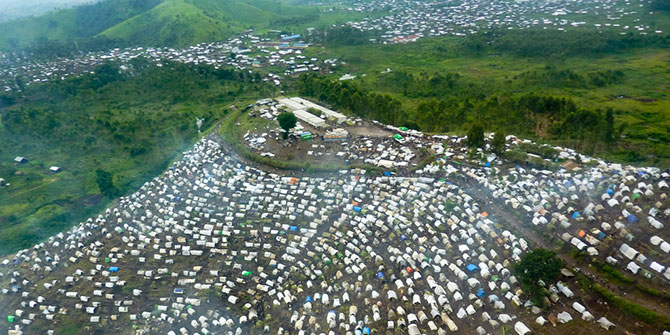Displacement can be caused by a variety of factors, and while this book Displacement Economies in Africa: Paradoxes of Crisis and Creativity gives some insight into the matter, LSE’s Janna Miletzki believes the book could have been improved with a narrower focus.
In Displacement Economies in Africa: Paradoxes of Crisis and Creativity, the editor Amanda Hammar presents a theoretical introduction to the book before showcasing ten case studies. In three parts, the volume argues that displacement can be the locus for economic rupture and repositioning, for the reshaping of economic sectors and for confinement. These chapters take examples of displacement of refugees, internally-displaced persons (IDPs) and returnees in various African countries. The introduction discusses the concept ‘displacement economy’ and other concepts relevant to the case studies, such as mobility, spatiality, agency and temporality. A relational concept of displacement is used here in order to enlighten the effects of displacement.
Part I concerns the economies of rupture and repositioning. It spans case studies from the Darfur-Chad borderlands, from Senegal and Zimbabwe. This part presents three main arguments: first, as argued in Andrea Behrend’s chapter, people who live in conflict zones (be it a refugee camp, village, town or major city) seek conditions of security in moments of insecurity and disruption. As such, the conflict zone (of Chad’s borderlands) becomes an interconnected displacement economy. The second argument presented is that ‘return’ to the place of origin is a complicated process of repositioning – as in the case of IDPs, who were displaced from Senegal to Guinea-Bissau in the 1990s, and came back to Casamance in the 2000s. As Martin Evans maintains, they were driven by the promise of better security conditions and international aid. Thirdly, Amanda Hammar argues that conflict generates structural violence, resulting in large-scale dislocation and displacement-in-place. For the working and middle classes in post-2000 Zimbabwe, social mobility was interrupted due to a policy of indigenisation.
Part II revolves around the reshaping of economic sectors, markets and investment, covering case studies from Angola, Kenya, Somaliland and Zimbabwe. The first argument by Cristina Udelsmann Rodrigues is that war in Angola shaped how different actors engaged in the diamond economy. Second, Hannah Elliott argued that in Nairobi’s Eastleigh Estate (Kenya), the camel milk trade created a common ‘Somali’ identity between the heterogeneous Somali population in Kenya. The trade of camel milk served Kenyan Somali pastoralists and refugee women from Somalia to generate income, while it would remind consumers of ‘home’. Third Peter Hansen argues that the Somaliland diaspora increasingly saw post-conflict Somaliland as an opportunity for private sector investments. Fourthly, Sarah Bracking maintains that in post-2000 Zimbabwe, parts of the economy itself got displaced. New structures, such as transnationalised electronic banking, emerged, which were used by elites and smaller players.
In the third part, arguments are presented about ‘confinement and economies of loss and hope’ in Uganda, Zimbabwe and DR Congo. Morten Boas and Ingunn Bjorkhaug contend that the conditions in IDP camps in Uganda functioned as a ‘prison economy’. The army had forced most of the rural population in the north to live in camps to protect them from the Lord’s Resistance Army (LRA), where they lived at the margins of existence. In the following chapter, Jeremy Jones maintains that Zimbabwe’s chronic crises led to confinement by structural violence, reminiscent of Hammar’s ‘displacement-in-place’. Despite their ‘stuckness’, young men are ‘hustling’ to make ends meet in their daily lives. Finally, Timothy Raeymakers describes a situation of war-generated dislocation in the eastern part of the DRC, where many of the two million IDPs were self-settled in abandoned buildings, forests or in host families. Reminiscent of the idea of repositioning in the first part of the book, it is argued that young men and women struggle to manage the often abusive labour conditions in urban areas, and to maintain effective relations.
This edited book shows the consequences of displacement in a vast array of settings. A main distinction is made between conflict-induced displacement and economic/structural displacement. The interpretation of ‘economy’ is broad; some chapters focus on the informal versus formal economy, some on economic opportunities. Others highlight particular economic sectors and how these were shaped by displacement. While this book thus offers insights into ‘displacement economies’ in various settings, the concept of ‘displacement economy’ still seems to be a rather loose umbrella term aiming to capture a multiplicity of issues including the complexities of return and structural violence, which would rather deserve to be discussed as issues on their own.
Displacement Economies in Africa: Paradoxes of Crisis and Creativity Edited by Amanda Hammar, Zed Books
Janna Miletzki has recently completed her PhD in the Department of Geography and Environment at LSE.
The views expressed in this post are those of the authors and in no way reflect those of the Africa at LSE blog or the London School of Economics and Political Science.






